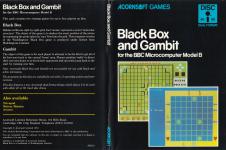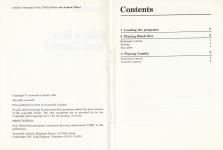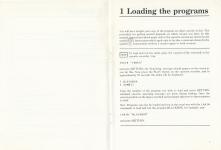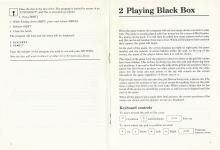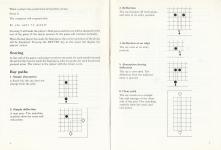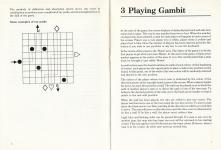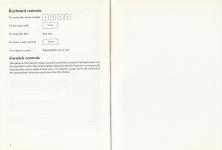


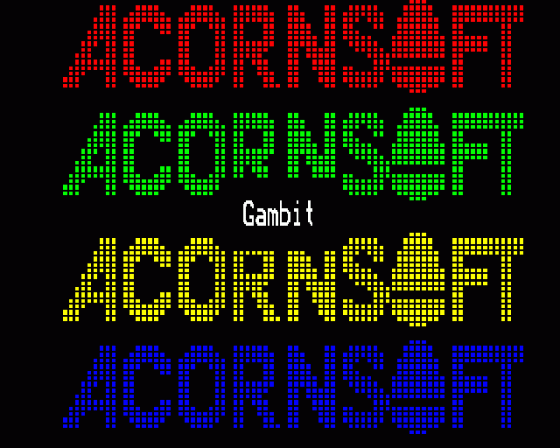
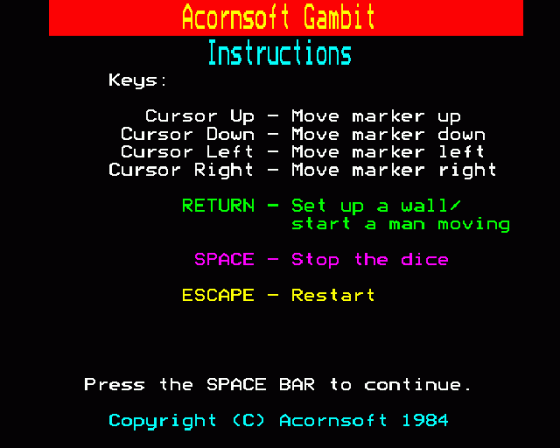

| Genre: | Compilation Of Arcade Games |
| Publisher: | Acornsoft |
| Contents: | |
| Cover Art Language: | English |
| Machine Compatibility: | BBC Model B |
| Release: | Professionally released on 5.25" Disc |
| Compatible Emulators: | BeebEm (PC (Windows)) PcBBC (PC (MS-DOS)) Model B Emulator (PC (Windows)) |
| Original Release Date: | 30th August 1984 |
| Original Release Price: | £12.95 |
| Market Valuation: | £4.00 (How Is This Calculated?) |
| Item Weight: | 144g |
| Box Type: | Cardboard Box (Decorative) |
Variant Items
There are 0 other items featuring this same game (that we know about!). Click any of them for their details.
Active Auctions
Closed Auctions
Buy It
Unfortunately no-one is currently selling this item.
Auction Price Watch
Worried you're being ripped off? Closing prices on eBay can help you decide what a reasonable price is for a particular item.
Full Instructions
Black Box And Gambit
This pack contains two strategy games for up to four players on cassette:
Black Box
Hidden within an eight by eight grid, four 'atoms' represent a secret 'molecular structure'. The object of the game is to deduce the exact position of the atoms by examining the paths taken by 'rays' fired into the grid. This computer version of the Waddingtons' Black Box game is produced under licence from Waddingtons Limited.
Gambit
The object of this game is for each player to attempt to be the first to get all of his four men back to the central 'home' area. Players position 'walls' to direct their own men home or to block their opponents and can send a man back to the start by running over him.
Note: Acornsoft Black Box and Gambit are not suitable for use with black and white televisions.
The programs on this cassette are suitable for use with 1.2 Operating System and later versions. They are also suitable for use with the Acorn Electron.
Playing Black Box
When the game begins, the computer will ask how many atoms you wish to play with. The game is usually played with four atoms but for a more difficult game, five atoms can be used. You will then be asked how many players wish to play and this can be any number from one to four. When all the players have entered their names, the game will begin.
At the start of the game, the screen displays an 8 x 8 grid, the game nmumber and the number of atoms hidden within the grid. At the top of the screen, the name of the player whose turn it is will be shown.
The object of the game is for the players to discover where in the grid the atoms have been hidden. This is done by firing rays into the grid and observing their exit positions. A ray can be fired from the edge of the grid at any position. Once a player has fired from a position, no other player can fire a ray from the same place but the entry and exit points of the ray will remain on the screen throughout the game, regardless of whose turn it is.
Players take turns to fire rays into the grid. Before firing a ray, a player can, if he wishes, guess the position of one or more atoms by marking them on the grid. Once a player has fired a ray his turn ends. When a player thinks that he has found all the atoms, he can tell the computer so and his turn is skipped until the end of the game.
When all the players have made their final guesses, the correct positions of the atoms are shown and the players' scores are displayed.
Game Controls
To move around the grid to fire a ray:
> - Clockwise, < - Anticlockwise, RETURN - Fire ray
To move within the grid to position an atom:
Cursor Up - Up, Cursor Down - Down, Cursor Left - Left, Cursor Right - Right, RETURN - Position/Remove Atom
When a player has positioned, all four/five atoms, press G. The computer will respond with
Do you want to guess?
Pressing Y will make the player's final guess and his turn will be skipped for the rest of the game. If the player presses N, the game will continue normally.
When the last player has made his final guess, the correct positions of the atoms will be displayed. Pressing RETURN at this point will display the players' scores.
Scoring
At the end of the game, each player receives one point for each symbol around the grid at the time he made his final guess, plus ten points for each incorrectly guessed atom. The winner is the player with the lowest score.
Ray Paths
-
Simple absorption
A direct hit, the ray does not emerge from the grid. -
Simple deflection
A near miss. Two matching symbols show the entry and exit points. -
Reflection
The ray bounces off both atoms and exits at its entry position. -
Reflection at an edge
The ray exits at its entry position. -
Absorption during deflection
The ray is absorbed. The deflection from the adjacent atom is ignored. -
Clear path
The ray travels in a straight line and emerges at the other side of the grid. Two matching symbols show the entry and exit points.
The methods of deflection and absorption shown above can occur in combination to produce more complicated ray paths, and disentangling these is the skill of the game.
Playing Gambit
At the start of the game, the screen displays a blank playing board and asks how many wish to play. This can be any number from two to four. When the number of players has been entered, a man for each player will appear in each corner of the screen. Player one is red, player two is white, player three is yellow and player four is blue. Once the number of players has been entered, press the fire button if you wish to use joysticks or any key to use the keyboard.
In the centre of the screen is the 'Home' area. The object of the game is to be the first player to get all of your men 'Home'. At the start of the game, a black arrow marker appears in the centre of the area. It is to this central point that a man must be brought to get safely 'Home'.
As well as four men, the board contains six walls of each colour. At the beginning of a move, each player has the opportunity to place a wall at any position on the board. At this point, one of the walls of his own colour will be randomly selected and placed in the new position.
The colour of the player whose turn is next is indicated by the colour of the direction arrows in the top right hand corner of the screen. When a player begins his move, he must first position a wall. The wall can be placed so as to block the path of another player's man or to direct the path of one of his own men. To indicate the desired position of the wall, move the black arrow marker so that it points to the new wall position.
When the wall has been placed, two dice are rolled to give two scores. The player can then move one or two men using the two dice scores. To move a man place the black arrow over him, pointing in the direction in which you wish him to move. The man will move in that direction until the dice score is exhausted or he hits a wall. If he hits a wall, the player must redirect him.
Light blue and flashing walls can be passed through. If a man is run over by another man, the man who has been run over will be returned to his starting corner. This rule applies even if both men are the same colour. However, when a man is in his corner, all other men must go around him.
Gambit Game Controls
To move the arrow marker, use the arrow keys.
SPACE - Set up a wall
Any key - Stop dice
RETURN - Start a man moving
Arrow keys - Redirect a man
The game can be played using a joystick instead of the keyboard. Use the joystick to move the arrow marker and press Fire to set up a wall, stop the dice and to make a man move. To redirect a man, move the joystick in the appropriate direction and press Fire.
Contents
INDEX
BLACKBOX
GAMBIT
Loading
CHAIN"INDEX" (RETURN)
Note: Programs can also be loaded and run in the usual way with the CHAIN command. For example, to load and run the program "Blackbox", type: CHAIN"BLACKBOX" (RETURN)
If you are using the disc version, place the disc in the disc drive. Hold SHIFT and tap BREAK.
Screen Designers
The following utilities are also available to allow you to edit the supplied screens of this game:
Cheats
Download
A digital version of this item can be downloaded right here at Everygamegoing (All our downloads are in .zip format).
| Download | What It Contains |
|---|---|
| A digital version of Black Box And Gambit suitable for BeebEm (PC (Windows)), PcBBC (PC (MS-DOS)), Model B Emulator (PC (Windows)) | |
| A digital version of Black Box And Gambit suitable for BeebEm (PC (Windows)), PcBBC (PC (MS-DOS)), Model B Emulator (PC (Windows)) |
Report A Problem
We thank you from the bottom of our hearts if you report something wrong on our site. It's the only way we can fix any problems!
You are not currently logged in so your report will be anonymous.
Add Note
Release Country
Change the country to update it. Click outside of this pop-up to cancel.
Scan Of Selected Article
If you auction an item, it will no longer show in the regular shop section of the site.




